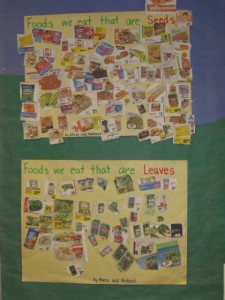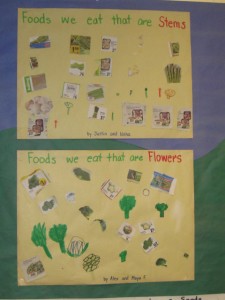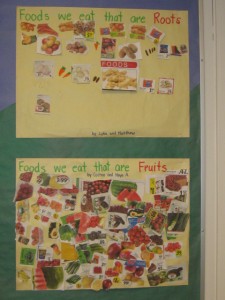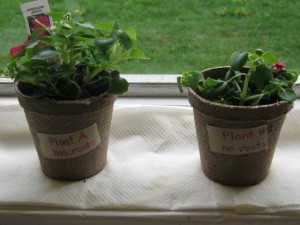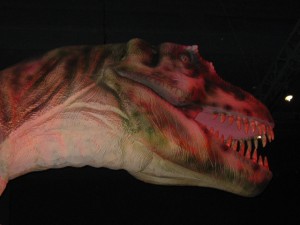We have completed a mini-unit on magnets. Students had fun experimenting with them and finding out what will attract (stick) and what will be repelled (not stick) to the magnets. We learned about the poles, how some metals are naturally magnetic, and how some can be made to be magnetic. Some of our experiments were a bit challenging due the age of our magnets and the need to get them re-magnetized! This will hopefully be looked into before they are used again. Oh, well. It was fun to play with them.
Category: Science
Our Maple Tree – Late Spring
Plants That We Eat
Students have been learning about the parts of a plant that we eat. In partners, they used grocery flyers to make collages for: stems, flowers, roots, leaves, seeds, and fruits.
Students really enjoyed this activity. It quickly became apparent that some of the partnerships had an easier time with this activity as we found that there were more foods which came from certain parts of the plants.
Those partners who worked with ‘fruits’ and ‘seeds’ found a lot more food products from those two groupings. The most challenging plant part to find foods from was the ‘flower’ group.
When students found a food item that they didn’t need for their own collage they scurried around and gave the pictures to the partnership that did need it. This was a great collaborative effort by the whole class.
This activity also gave the students a better understanding of our food sources.
Nasturtiums
Experiments with Plants
The past two weeks have been busy, and fun-filled, with learning about plants. We have done several experiments with existing plants to determine the use that plants have for their different parts. We have also planted some seeds of our own which we are anxiously awaiting to sprout.
The first experiment we did was taking a small plant apart and looking at its various parts. Students saw how the roots form a ‘ball’ in the soil and that when the soil is carefuly removed the roots are long and delicate. We closely examined the stem and its many branches and saw buds forming amongst the leaves. The students know that these buds develop into the plant’s flowers. We then re-potted the plant.
For our second experiment we put celery in water with food colouring. We had one water-glass coloured with blue and one with red. We left some celery in a jar of water with no food colouring in it, as well. We also put one white flower in a jar with green food colouring. We left these to sit on the window ledge overnight. The next day we saw this:
We cross-cut some parts off the bottom of the celery stems to see the straw-like tubes that form the stem of the celery. Students discovered that plants have these tubes in their stems to draw up water from the ground to the other parts of the plant. They could tell that the celery had drawn up the water as the leaves at the top had changed colour.
Our third experiment was focussed on the need a plant has for its root system. We took two plants and transplanted one – in its entirety – into a new, larger pot. With the second plant we cut it from its roots at the dirt level and then ‘planted’ it into a new pot filled with soil. We recorded how they both initially looked (through drawings) and we will re-visit them next week to record any differences. The next day we already noticed some changes in the ‘rootless’ plant.
Just to see what might happen, we also re-potted the root system that we cut off into a third pot. All three of these pots are sitting in the window ledge and are being watered regularly. We will be watching them each day to note any changes.
We have planted nasturtium seeds into clay pots that the students collaged with tissue paper and which were sealed with Mod Podge (similar to acrylic medium). We are hoping to see some greenery sprouting this week.
We have also got two avocado pits suspended in water glasses – one with the pointy end down and the other with the rough end in the water. Students made predictions as to which pit will sprout roots. This will take a number of weeks so we will just have to be patient and wait.
We will be continuing our plant unit over the next few weeks and look forward to making more discoveries.
Our Day at Science World!
Today we had a fun and exciting learning experience at Science World. Arriving via school bus we began our day in the visiting Dinosaur exhibit room. We were thrilled to see the life-sized models of some dinosaurs that we have learnt about – and some others that we hadn’t.
Triceratops is always a favourite as he is an herbivore but one who doesn’t let Tyrannosaurus Rex – the greatest meateater of the last era of the Dinosaur Age (the Cretaceous Period) – get the better of him.
We were not too surprised to see Velociraptor shown with feathers as we have learnt that our modern-day birds are descendents of the dinosaurs. Still, it is a little unnerving to think of a 6 foot tall meat-eating ‘bird’ running around!
When we were finished in the Dinosaur Room we went across the hall and spent some fun time exploring the Search Gallery. Students really enjoyed roaming around the beaver lodge and exploring inside the hollow tree. We met up with the other two divisions in the lunch room for our meal break.
We wandered up the long, long ramp (200 metres) to the Omnimax Movie Theatre where we enjoyed the large movie screen and the film Dinosaurs Alive! This film really explained how fossils were often trapped under soil due to monsoons, flash floods, or land slides. Some dinosaur remains were found in positions that showed they had been in a conflict situation at the time – i.e. two dinosaurs trapped together in mid-fight – or when they were protecting their nests of eggs.
After the movie we explored the Eureka! gallery, the Lego Exhibit, and the puzzle tables on the main floor before collecting our coats and heading outside to the bus. The students were well behaved and were very keen on the whole experience. All in all, it was a very fun and enjoyable day!



